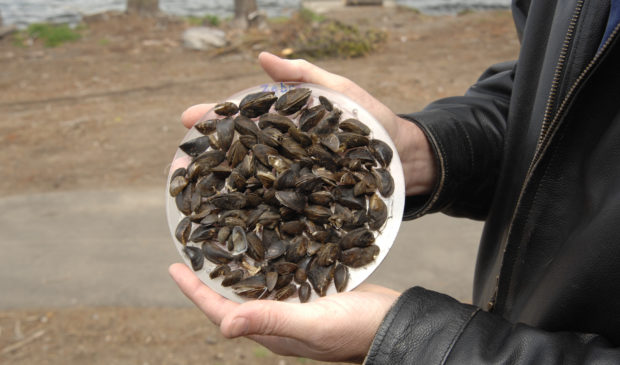Permanent zebra mussel solution still 18 months out
Friday, February 22, 2019 by
Jessi Devenyns Following the odorous indication that a zebra mussel infestation had arrived in Austin waterways earlier this month, Austin Water has been working to come up with a solution to prevent a similar instance from recurring.
Austin Water is already working to slow the population of zebra mussels by using chemical retardants in its piping systems and raw water tunnels. However, due to the speed with which these bivalves reproduce, it is not enough, according to Mehrdad Morabbi, an operations manager for Austin Water, who addressed the Environmental Commission at their Feb. 20 meeting.
After first appearing in 2017 in Austin’s jurisdiction of the Highland Lakes system, the mussels have spawned at such a rate that Austin Water reported a ½- to 2-inch-thick layer of mussels at every water treatment facility intake this past January. This already critical situation is compounded by the fact that “we could essentially look at a year-round spawning season,” said Morabbi.
With the possibility of tens of millions of nickel-sized mussels covering every hard surface within Austin lakes, the water utility is quickly searching for a solution. Unfortunately, the least expensive and most effective option of copper ionization is not readily available. According to Morabbi, the implementation of the electrolytic process that adds a very low dose of copper to the water and that is toxic to the mussels is still 18 months out. The water company is working with an outside consultant, the engineering firm Black and Veach, to develop the copper-ion system.
In the interim, Austin Water is planning on using a combination of manual removal of the mussels along with a sodium permanganate solution. Although effective, the sodium permanganate solution is significantly pricier than using copper.
To combat the mussels with a copper solution it will cost roughly $200,000 per annum. Meanwhile, to use sodium permanganate, it “would be roughly $1 million for an annual contract,” explained Morabbi. “But we need it, and we’re going to use it.” This will come on top of the $212,000-per-year diving contract that Council approved last June.
According to the Watershed Protection Department, there is no way to eradicate these mussels without damaging the natural ecosystems of the lake. Nor is there an environmentally friendly solution akin to grass carp that would function as a natural predator to this invasive species.
Commissioner Mary Ann Neely did ask if the mussels were edible in hopes that the city could consume their way out of this problem. However, Morabbi noted, “I haven’t seen garlic butter as a mitigation technique.”
Still, there is still some consolation to be had from the fact that the first spawning season is generally the worst. After the initial bloom, generally limiting natural factors keep populations at a steady state.
That’s not to say that things won’t get worse before they get better. As Austin Water works to keep populations under control, Liz Johnston, a program coordinator at the Watershed Protection Department, brought the commissioners’ attention to the fact that as filter feeders, these mussels will not only clog water intakes but they will allow the blue-green algae in the lakes to flourish more easily and their population will continue to spread downstream which will pose a risk to swimmers and recreational water users because of their sharp shells.
Morabbi admitted that the water utility “really won’t be able to do anything with the lake,” but he did assure the commissioners that Austin Water is working to ensure clean, safe drinking water for Austinites despite the infestation.
The Austin Monitor’s work is made possible by donations from the community. Though our reporting covers donors from time to time, we are careful to keep business and editorial efforts separate while maintaining transparency. A complete list of donors is available here, and our code of ethics is explained here.
You're a community leader
And we’re honored you look to us for serious, in-depth news. You know a strong community needs local and dedicated watchdog reporting. We’re here for you and that won’t change. Now will you take the powerful next step and support our nonprofit news organization?



